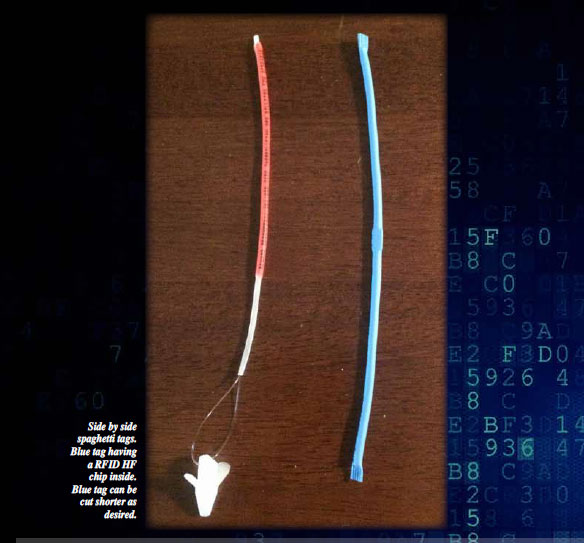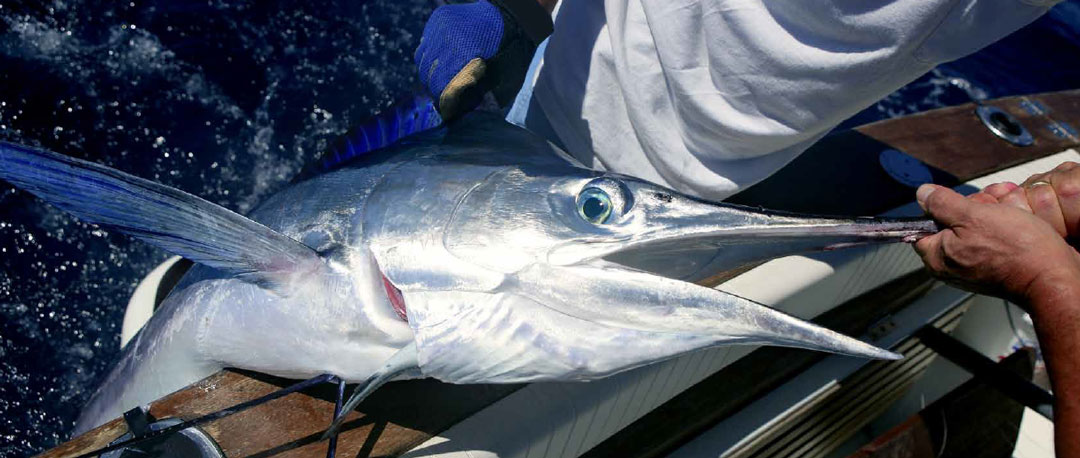INTRODUCING iTAG - A TOTALLY NEW REVOLUTION
RFID & Bluetooth technology will make it easier to tag and track fish for enhanced environmental and biological data.
by Capt. Dave Lear - December 19, 2017
It was a memorable battle on 30-poundtest line. The spunky blue marlin inhaled the skirted bait before launching skyward in an effort to escape. Half the spool and several somersaults later and the defeated billfish lay on its side next to the boat. A traditional plastic fish tag was quickly inserted just below the dorsal fin, the hook was removed and with a defiant flick of its tail the blue disappeared back into the cobalt depths.
So what happens next? Hopefully the associated tag card is not lost, is accurately filled out by hand before it is stamped and mailed back to the issuing organization, maybe days or even weeks later. Someone on payroll at a computer will then manually enter the catch information into a database. Those details eventually become part of an annual report but the unique characteristics of the catch are limited unless another angler lands that same marlin and reports the re-capture. And the slow, cumbersome process goes on, as it has for decades.

The more recent development of satellite fish tags is a major advancement in technology and usable data. Data relays are more immediate and accurately detailed thanks to larger memory capacity. The operation is short-lived, however, and the large size of the tags mainly limit their use to larger animals like billfish and sharks. At an average of $5,000 per tag, the cost prohibits mass distribution. But another technology that is widely used in numerous industrial applications offers a new alternative for fish tags. Radio frequency identification or RFID iTAGs will allow more user-friendly deployment and registration, greater longevity and “Much more data will be cataloged and the tag can remain in the animal indefinitely. So if it’s caught again it doesn’t have to be killed and we can overlay the most recent data with the previous set to plot movement patterns recapture after recapture...” decreased administrative needs, all at virtually the same cost as the traditional plastic fish tags. The Bisbee’s Fish & Wildlife Conservation Fund is on the cusp of launching a comprehensive RFID tagging program.

“RFID technology has been around for more than 20 years,” explains Mike Bondurant, a technology consultant for the BFWCF. “It’s been used more as a logistics tool to track packages, equipment, retail items and produce. The cost of the tags were $3 to $5 apiece years ago but now those unit prices are down to dimes and pennies, which makes them viable for fish tags. Here’s how they work. Embedded in the tag is a passive chip that has no battery. It acts as an antenna. A sensor, or in our application a smart phone, has enough power to activate the antenna in the chip to transmit the data. Each one has a unique identifier to detect a specific fish.” All of the information is transferred via a smart phone versus filling out a form and licking postage stamps.
Bondurant says there are three kinds of RFID tags that are applicable for fish identification. Passive low frequency tags have been used to count freshwater trout in holding ponds. Low frequency radio waves travel easily through the water but a stationary receiver is required, similar to a security gate at a store. The fish must swim through a checkpoint to be counted, which is not practical for far-ranging marine species. Tags with high frequency (HF) chips still transmit well and are small enough to not impede a fish’s movement. The passive chip’s memory capability can capture critical information like date, time and location of the catch.
This type of passive high frequency tag is the first phase of the BF&WCF’s RFID iTAG Program where much more data will be collected than the traditional spaghetti tags. Manual data entry is dramatically reduced and much more valuable data is collected while enhancing data integrity.
The third type of RFID technology that’s suitable for fish tracking is Bluetoothenabled. Bluetooth tags incorporate an active beacon, which requires a battery. The increased memory can store more data immediately for transmission and between the time of multiple recaptures. With the added capability, the price tag is slightly higher than the two passive formats. BFWCF plans to release the Bluetooth enabled tag options in the applications second release.
There are physical considerations with RFID ITAGs as well. Bluetooth tags are about the size of a lip balm or lip stick tube, so they are best suited for medium to large sized fish or pelagic species like billfish and sharks. Passive HF tags are similar to the current spaghetti streamer tags or a cocktail straw, with the embedded chip about the size of a Pez candy. The reduced size and hydrodynamics of those make them suitable for inshore and nearshore species like redfish, tarpon, striped bass and salmon. The tags themselves must be totally water-proof, durable and able to withstand different pressure and temperature ranges.

“There are literally hundreds of manufacturers of RFID tags now,” Bondurant adds. “The key is finding the right tag for the right situation. I’ve already identified a few that will work.” The tag anchors will consist of nylon or another synthetic material and the tag itself will be attached like traditional tags using a pointed tag stick inserted into a caught fish.
“I’m an angler too and I’m excited about this opportunity,” Bondurant says. “The ability to record critical information about a catch in a passive way is beneficial, especially since the transfer will require limited manual tasks other than operating the phone. Much more data will be cataloged and the tag can remain in the animal indefinitely. So if it’s caught again it doesn’t have to be killed and we can overlay the most recent data with the previous set to plot movement patterns recapture after recapture. Think what we can learn from fish like sharks and sailfish that return to the same areas year after year. That data will yield a ton of information that will help all interested stakeholders. To me, the automated component of RFID itTAGs is the biggest step forward from a conservation and research point of view.”
Dave Garcia, who created the software CatchStat.com a registration and real time scoring system for fishing tournaments, is another consultant working on the Conservation Fund’s RFID iTAG Program. Garcia is developing the database, web application and mobile app that is the key interface for the system.
“The iTAG will be a smart tag to catalog as much data in the capture and subsequent recaptures,” Garcia explains. “It’s definitely a step up from the traditional tag and the beauty of it is you’ll be able to use a smart phone or tablet to activate it and automatically record the data. The whole process will be fast and less invasive for the fish.”
After the tag is inserted, the free phone app will enable the user to select the species, add the angler/boat names and submit. It will be a simple procedure using a device most anglers have access to these days. The app will also include a media component where the user can upload a photograph or short video clip of the catch. The end result is a more participatory and interactive system for anglers while bringing a badly needed upgrade to dated tagging systems for the scientific community.
“All data submitted will load into our secure, cloud-hosted database,” Garcia says. “Using NOAA information, we will couple the data with analytical overlays like atmospheric temperature, barometric pressure, sea surface temperature, moon phase, weather and tides. Anglers can use the app or social media to check out the data in general terms or by specific regions.
“Mike and I have been thinking about this concept for a long time,” he adds, “And now we have the proven, cutting-edge technology to make it happen. It’ll take fish tagging to a whole new level.”
BFWCF President Wayne Bisbee agrees.
“This is a revolutionary deal,” Bisbee says. “At nearly the same cost as traditional tags, with the iTAG system and smart phones, we can record data instantly, reduce manpower and make everything interactive. It’s the cool factor, for sure, and it’ll get more anglers participating and bring new life to tagging efforts.”
Bisbee says the database will be available to scientists and he hopes to work with other conservation groups in the future. Billfish will be the main focus for the BF&WCF at first, but other inshore and nearshore species will be phased in as the program grows.
“We’re planning to have the tags ready for distribution by late spring and jump-start the database with some iTAG tournaments in Cabo as early as this summer,” says Bisbee. “We’re going to target charter operations, lodges and tournaments to get as many anglers and crews participating as possible. I also want to develop a rewards program with tackle and other prizes as incentives. This cutting edge technology is here and readily available to help expand our knowledge of these important animals.So the time is right to kick this thing off and start sticking some fish.”